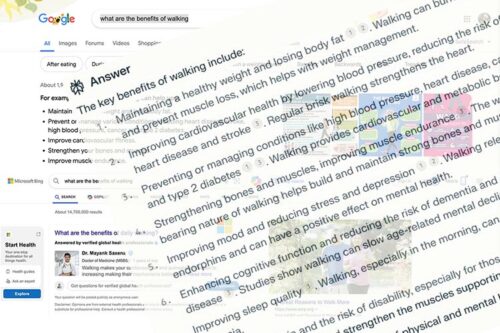February 12, 2025
Many years ago, a friend told me about an artist in California who’d created a performance with chairs in a body of water. She couldn’t remember the artist’s name, just this vivid image. I recall typing “artist in California performance with chairs in water” into Google, and there it was – the artist’s website appeared at the top of the search results.
Today, that search no longer works. The artist has a new website, and while the piece is on her new website, the text that made it findable is gone. She’s well-known enough now that this might not matter for her, but for artists still working toward recognition, this is a lost opportunity.
Interestingly, the same artist (whose name I now know) created a similar piece in Hannover a few years back. Through some digital detective work, I discovered Google could find the website if I incorporated an exact phrase she uses on the website. She used this phrase: “performers arrange and re-arrange chairs” so I incorporated that into my search query: “performers arrange and re-arrange chairs in water hannover”. But unless you happen to think in those precise words, you might never find it by your own Googling.
Here’s the work that my search query describes, in case you’d like to test this search in Google against others that might have occurred to you to try:

This gets at the heart of how traditional SEO has always worked: you need text that matches how people actually search. Not just in your visible content, but in your page titles, meta descriptions, and image alt tags – all those hidden places that search engines read.
The AI Revolution in Art Discovery
The way people search is changing, however. You’ll have seen how Google now buries traditional organic website results beneath AI summaries and social posts. I’ve migrated to Perplexity.ai for more helpful search results and I know this is true for many others. Perplexity can interpret more complex queries, you can upload references, and you can refine your search conversationally.
I tried this query in Perplexity:
Can you find for me the website of an artist who has, in the past, done performances where she rearranges chairs in a body of water?
Bingo. Found the artist in a flash (it didn’t provide the url of the website but that’s ok—it provided her name, from which one can track down her website).
I then tried this query (also in Perplexity):
“Can you find for me the website of an artist who has, in the past, done performances where she moves chairs around in a body of water?”
This was more the kind of language I would have thought to use myself—and that one failed.
So while Perplexity was better than Google at tracking down this artist by understanding that a “body of water” includes rivers and pools (without having to explicitly use those words) and didn’t need “Hannover” or “Los Angeles” to find the artist, it still failed when I expected it to understand that “moves chairs around” is the same thing as “rearranges chairs”.
With the rate at which AI is improving, however, it won’t be long before the second query works too.
An Experiment for Curating a Film Program using AI
To see if Perplexity would have been helpful for something I already did manually once, I made an experiment based on a film program I’d curated in 2006. The program had explored “the terrain between our instincts for the security of certainty and our tentative curiosity for exploring the unknown.” Back then, I’d spent days manually searching the Filmmakers’ Coop catalogue for suitable films.
Using Perplexity to search the same catalogue today yielded interesting results. I used this search at first:
“Please give me a list of short films in the catalogue of The Filmmakers’ Coop (NYC) that would be suitable for a program of films around the theme of “the terrain between our instincts for the security of certainty and our tentative curiosity for exploring the unknown”.
The initial suggestions missed the mark a bit, focusing too much on overtly symbolic works. But then I refined my query with this follow-up:
“These films have a tenuous connection with the theme. I’m looking for films that undermine our sense of certainty about reality, rather than films that “potentially symbolize” or “could represent” or “might depict” or “could symbolize ” or “potentially represent”. I’d like films that can make an audience realize that there are alternate points of view (but without being didactic films that obviously tell you that).”
This resulted in finding several films that I’d consider looking at.
I then shared my original program selections with Perplexity and asked it to reverse-generate a more sophisticated search prompt than I’d initially used. This was the introduction to my query:
“The question I asked in the beginning was related to an actual program that was run in 2006. I was trying to see how a curator could ask you to research the film catalog to create this program. You came up with several films that do sound interesting and related to the theme but still you didn’t pick any of the choices that were in the program itself. I am going to paste the notes for the whole program below. Please give me a prompt that might have resulted in you finding a selection of films that are more like the ones that were in the program (if not these very films) without me knowing, in advance, any films that might be suitable:”
Perplexity generated a long prompt that it summarized as: “[a prompt that] captures the essence of the program you described without specifying any particular films. It emphasizes the exploration of uncertainty and the questioning of fixed perspectives, which are central themes in the films you listed. It also allows for a diverse range of experimental techniques and subject matter, similar to the variety seen in your original program.” Using Perplexity’s full prompt, I ended up finding even more suitable-sounding films than I might have found otherwise.
I wouldn’t want to rely solely on AI for this kind of research just yet—it’s still a challenge to communicate to AI all the nuances of the ways our brain is thinking and you don’t know what the AI-search might be missing that you could have tracked down. Especially when the descriptions the filmmakers wrote about their films might only hint at matching what I was looking for—in ways Perplexity might not recognize. But it’s a great way to get more ideas quickly and I’m pretty sure savvy curators will have added this to their toolbox already. So: worth optimizing for.
What This Means for Artists Now
From both my chair-performance search and my film-curating experiment the same thing is true: your work is more findable when you use words and phrases on your website that people use when searching. But now that your words and phrases are being parsed by AI, there’s room to think of search optimization differently.
AI is giving us new strategies and it’s getting smarter by the day. You will still need to have text that corresponds to the intention of the search query. But there’s room, now, for this text to be effective without needing to be such an exact match to a search phrase—and this is going to become more and more true.
Somewhere, someone is looking for work like yours. You might think Instagram is the best platform for discovery by curators and collectors (it is good), but these changes with AI suggest that there’ll be great opportunities just with your own website—and you won’t need to worry about things like the mysterious “spam” blocks people have been experiencing on Instagram.
Every piece of text on your website is an opportunity to be found by a search, so if you could use a little discovery, now’s a good time to get some text on your website that AI-powered search can work with. Get ahead!




